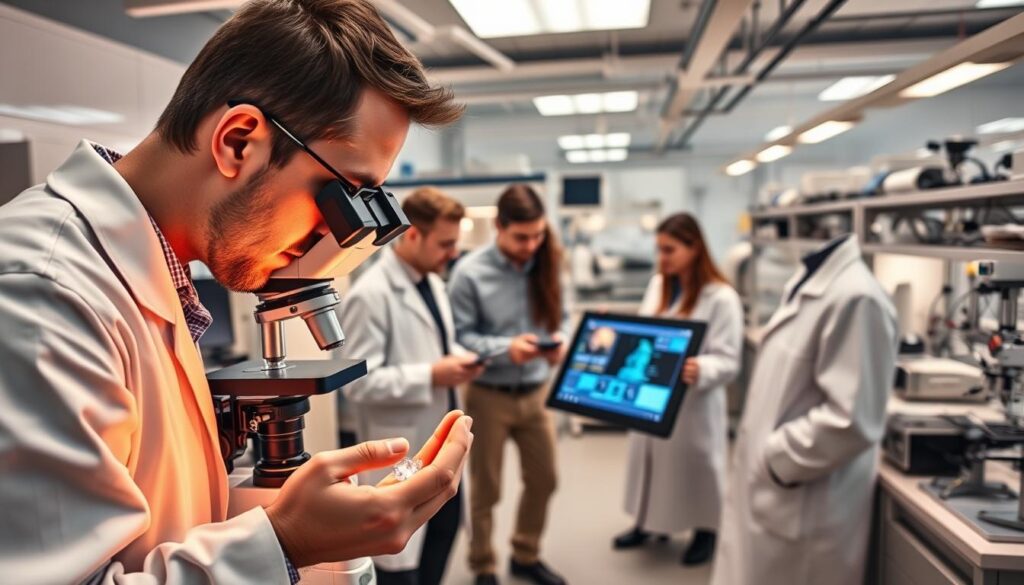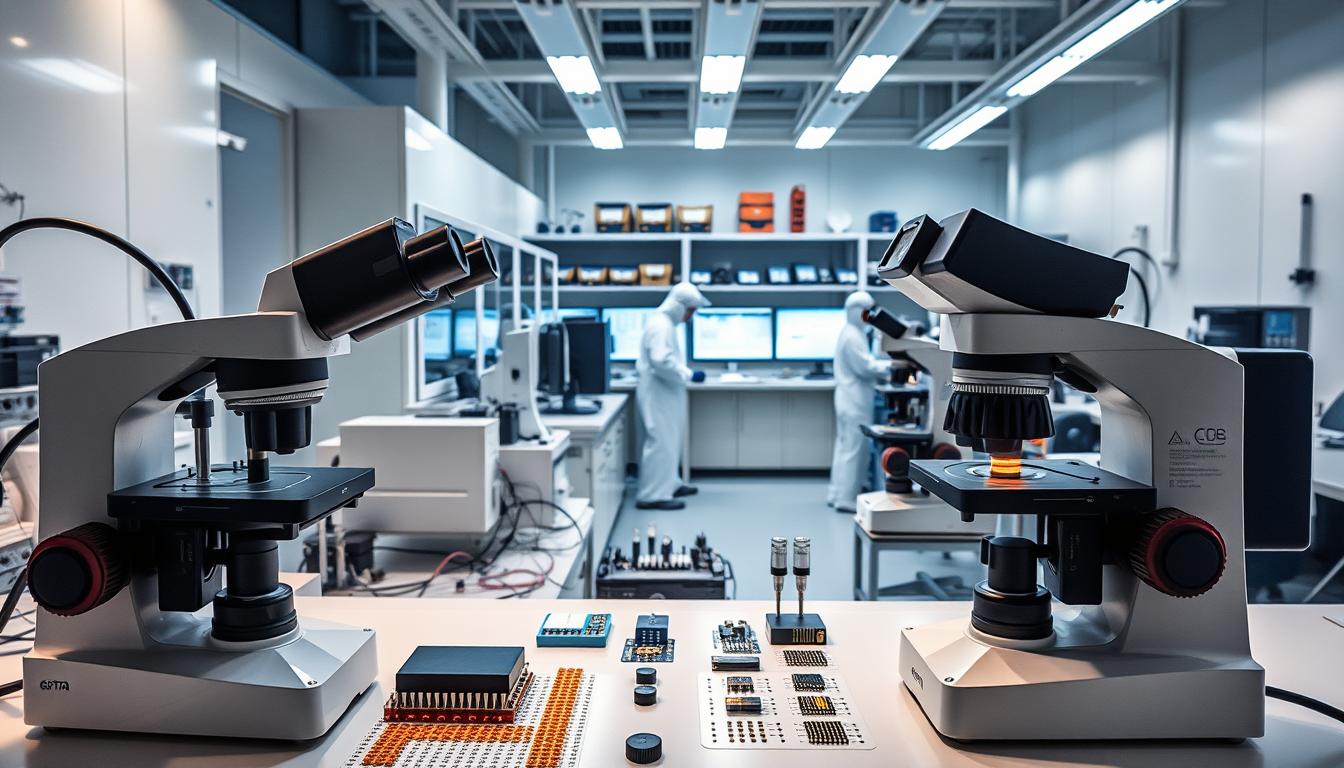Germany is a hub for nanotechnology research, with institutions like the Fraunhofer Institute for Interfacial Engineering and Biotechnology leading the way in nanosensor development and material characterization. These laboratories are equipped with state-of-the-art equipment, enabling researchers to develop and test new nanosensors and materials.
The work done here has significant implications for various industries, including healthcare and environmental monitoring. The Fraunhofer Institute and other German research institutions are at the forefront of this research, driving innovation and advancements in the field.
Key Takeaways
- Germany is a leading hub for nanotechnology research and development.
- The Fraunhofer Institute is a key player in nanosensor development.
- State-of-the-art equipment enables cutting-edge research.
- Research has significant implications for healthcare and environmental monitoring.
- German research institutions drive innovation in the field.
Overview of Nanosensor Technology
Nanosensors, being highly sensitive devices, play a crucial role in advancing sensor technology. They are designed to detect and measure various physical and chemical parameters at the nanoscale, offering unprecedented precision in numerous applications.
The significance of nanosensor technology lies in its ability to provide accurate and reliable data in real-time, which is vital for decision-making in various industries. The integration of nanostructure characterization techniques has further enhanced the capabilities of nanosensors, enabling detailed analysis of material properties at the nanoscale.
Definition and Importance
Nanosensors are defined as devices that operate at the nanoscale, typically measuring parameters such as temperature, pressure, and chemical composition. Their importance stems from their high sensitivity and ability to detect minute changes in their environment, making them invaluable in fields requiring precise measurements.
The use of advanced materials testing methods has been instrumental in the development of nanosensors, allowing for the thorough evaluation of their performance and reliability. This has paved the way for their application in critical areas such as healthcare and environmental monitoring.
Key Applications in Various Industries
Nanosensors have a wide range of applications across different industries. Some of the key areas include:
- Healthcare: Nanosensors are used for medical diagnostics, enabling the early detection of diseases and monitoring of patient health.
- Environmental Monitoring: They help track pollutants and monitor environmental conditions, contributing to a safer and healthier environment.
- Industrial Processes: Nanosensors are used to monitor and control industrial processes, improving efficiency and reducing costs.
The versatility of nanosensors, coupled with advancements in nanosensor technology, is expected to drive further innovation in these and other fields.
Germany’s Leadership in Nanosensor Research
Germany’s leadership in nanosensor research is built on a foundation of historical excellence and recent breakthroughs. The country’s strong research infrastructure and significant investment in nanoscience have positioned it at the forefront of nanosensor technology.
Historical Context
Germany has a long history of excellence in nanoscience research, dating back to the early 20th century. The country has a tradition of fostering innovation and has been at the forefront of scientific advancements. This historical context has laid the groundwork for current achievements in nanosensor research.
The development of nanosensors in Germany has been influenced by its strong academic and industrial base. Research institutions have played a crucial role in advancing the field, with significant contributions from both public and private sectors.
“The future of nanosensor technology lies in its ability to integrate with various fields, such as medicine and environmental science, to create innovative solutions.”
Recent Advancements in the Field
In recent years, Germany has seen significant advancements in nanosensor technology, particularly in improving the sensitivity and functionality of nanosensors. These advancements have enabled new applications in fields like medicine, where nanosensors are used for diagnostic purposes, and environmental science, where they are used for monitoring pollutants.
| Application Area | Description | Impact |
|---|---|---|
| Medical Diagnostics | Nanosensors for detecting biomarkers and pathogens | Early disease detection and personalized medicine |
| Environmental Monitoring | Nanosensors for detecting pollutants and toxins | Improved environmental health and safety |
| Industrial Processes | Nanosensors for monitoring and controlling processes | Increased efficiency and reduced costs |
The integration of nanosensors in various industries is expected to drive further innovation, with Germany remaining at the forefront due to its robust research infrastructure and commitment to scientific excellence.
Major Nanosensor Development Labs in Germany
Germany’s nanosensor development landscape is characterized by the presence of leading research institutions such as the Fraunhofer Institute and Max Planck Institute. These institutions are pivotal in advancing nanosensor technology through their cutting-edge research and innovative approaches.
Fraunhofer Institute for Interfacial Engineering and Biotechnology
The Fraunhofer Institute for Interfacial Engineering and Biotechnology is a leading research institution in the field of nanosensors, particularly known for its work on biosensors and nanotechnology. Their research focuses on developing novel sensor technologies that can be applied in various fields, including healthcare and environmental monitoring.

Max Planck Institute for Colloids and Interfaces
The Max Planck Institute for Colloids and Interfaces is another prominent research center in Germany, contributing significantly to the fundamental science behind nanosensors. Their work involves understanding the interactions at the colloidal level, which is crucial for developing advanced nanosensor technologies.
Karlsruhe Institute of Technology
Karlsruhe Institute of Technology (KIT) is also a key player in nanosensor development, with a focus on integrating nanosensors into various applications. KIT’s research encompasses a broad range of areas, from materials science to engineering, facilitating the development of practical nanosensor solutions.
These institutions are well-equipped with state-of-the-art facilities and are supported by lab equipment suppliers who provide the necessary tools for their research. The collaboration between these labs and industry partners is crucial for advancing nanosensor technology and bringing innovative solutions to the market.
Material Characterization Techniques in Nanosensor Development
Advanced material characterization is a cornerstone in the creation of high-performance nanosensors. The properties of materials used in nanosensors directly influence their sensitivity, selectivity, and overall performance. Therefore, employing sophisticated characterization techniques is crucial for understanding and optimizing these materials.
Electron Microscopy
Electron microscopy is a powerful tool for characterizing the morphology and structure of nanoscale materials. Techniques such as Transmission Electron Microscopy (TEM) and Scanning Electron Microscopy (SEM) provide high-resolution images of nanoparticles, nanowires, and other nanostructures used in nanosensors. As noted by experts, “Electron microscopy has revolutionized the field of nanotechnology by enabling the visualization of materials at the atomic scale.”
Atomic Force Microscopy
Atomic Force Microscopy (AFM) is another critical technique for characterizing the surface topography of nanomaterials. AFM provides detailed information about the surface roughness, particle size, and other morphological features that are essential for optimizing nanosensor performance. According to a recent study, “AFM has become an indispensable tool in nanotechnology research, offering unparalleled resolution and versatility.”
Spectroscopy Methods
Spectroscopy methods, including Raman spectroscopy, Fourier Transform Infrared (FTIR) spectroscopy, and X-ray Photoelectron Spectroscopy (XPS), are vital for analyzing the chemical composition and electronic structure of nanomaterials. These techniques help researchers understand the interactions between the nanosensor materials and the target analytes, thereby enhancing sensor performance. As highlighted by a leading researcher, “Spectroscopy techniques are fundamental in elucidating the properties of nanomaterials and their interactions, which is crucial for the development of efficient nanosensors.”
In conclusion, the combination of electron microscopy, atomic force microscopy, and various spectroscopy methods provides a comprehensive understanding of the materials used in nanosensors. This knowledge is essential for optimizing nanosensor performance and advancing their applications in various fields.
Integration of Nanosensors in Industry
The integration of nanosensors into various industries is revolutionizing the way we monitor and control processes. This technological advancement is particularly significant in sectors such as healthcare, environmental monitoring, and the development of smart materials and structures.
Healthcare Applications
In the healthcare sector, nanosensors are being utilized for early disease detection and monitoring. They enable the precise measurement of biomarkers, facilitating timely interventions. For instance, nanosensors can be integrated into diagnostic devices to detect cancer at an early stage, improving patient outcomes.
Key Benefits in Healthcare:
- Early disease detection
- Personalized medicine
- Minimally invasive diagnostics
Environmental Monitoring
Nanosensors are also being employed for environmental monitoring, tracking pollutants and providing real-time data on environmental conditions. This application is crucial for maintaining ecological balance and ensuring public health.
Examples of Environmental Monitoring:
- Detection of water pollutants
- Air quality monitoring
- Soil contamination assessment
Smart Materials and Structures
The development of smart materials and structures is another area where nanosensors are making a significant impact. By integrating nanosensors into materials, it is possible to create structures that can monitor their own condition and respond to changes in their environment.
| Industry | Application | Benefit |
|---|---|---|
| Healthcare | Disease detection | Early diagnosis |
| Environmental | Pollutant tracking | Real-time monitoring |
| Materials Science | Smart structures | Self-monitoring capabilities |
Funding and Support for Nanosensor Projects
The development and commercialization of nanosensor technology are significantly influenced by the availability of funding and support. Government and private investments are crucial for the progression of nanosensor technology, facilitating innovation and commercialization. This dual support system enables researchers to explore new ideas and industries to integrate these technologies into practical applications.
Government Initiatives
Government initiatives play a vital role in supporting nanosensor research, particularly in the early stages. Funding programs and grants provided by government agencies help researchers to explore novel concepts and develop prototypes. For instance, the German Federal Ministry of Education and Research (BMBF) has launched several initiatives to support nanotechnology research, including nanosensors.
These government-backed programs not only provide financial support but also foster collaboration among research institutions, universities, and industry partners. By doing so, they accelerate the development and commercialization of nanosensor technologies.
Private Sector Investments
Private sector investments are equally important for the advancement of nanosensor technology. Companies investing in nanosensor research and development help to drive innovation and bring new products to the market. Private investments often focus on the commercialization and scaling up of nanosensor technologies, making them more viable for industrial applications.
Moreover, collaborations between private companies and research institutions can lead to the development of novel nanosensor applications, further expanding the potential of this technology.

The synergy between government initiatives and private sector investments creates a robust ecosystem for nanosensor development in Germany. This combined support is essential for overcoming the challenges associated with nanosensor technology and for driving its future growth.
Collaborative Research in Nanosensor Science
Nanosensor science is benefiting greatly from collaborative research initiatives that bring together diverse expertise. By fostering a culture of cooperation, researchers can share knowledge, resources, and risk, accelerating the development of nanosensor technologies.
University Partnerships
University partnerships play a crucial role in advancing nanosensor research. Collaborative projects between academia and industry partners enable the translation of scientific discoveries into practical applications. For instance, the partnership between the University of Hamburg and the Fraunhofer Institute has led to significant advancements in nanosensor technology for healthcare applications.
Such collaborations not only enhance the research capabilities of the involved institutions but also provide a platform for students and young researchers to engage in cutting-edge projects, thereby nurturing the next generation of scientists and engineers.
Key Benefits of University Partnerships:
- Innovation through interdisciplinary collaboration
- Access to state-of-the-art research facilities
- Enhanced career opportunities for researchers
International Collaborations
International collaborations are vital for tackling the global challenges associated with nanosensor development. By working together across borders, researchers can leverage diverse perspectives and expertise, leading to more robust and versatile nanosensor technologies.
“International collaboration is essential for advancing nanosensor science. It allows us to pool our resources and expertise, addressing complex challenges more effectively.” – Dr. Maria Rodriguez, Nanosensor Researcher
A notable example of international collaboration is the European Union’s Horizon 2020 program, which has funded numerous nanosensor research projects involving partners from multiple countries. This not only accelerates the development of nanosensors but also facilitates their adoption across different markets.
| Institution | Country | Research Focus |
|---|---|---|
| University of Hamburg | Germany | Nanosensors for Healthcare |
| Stanford University | USA | Nanosensor Applications in Environmental Monitoring |
| University of Cambridge | UK | Advanced Materials for Nanosensors |
Challenges in Nanosensor Development
Several challenges hinder the progress of nanosensor development, affecting their technical performance, regulatory compliance, and market viability.
Technical Barriers
The fabrication and operation of nanosensors pose significant technical challenges. Ensuring the stability and reliability of these sensors is crucial for their successful application.
Some of the key technical barriers include:
- Scaling down sensor components to the nanoscale while maintaining their functionality.
- Achieving high sensitivity and selectivity in complex environments.
- Developing robust calibration methods for nanosensors.
| Technical Challenge | Description | Potential Solution |
|---|---|---|
| Nanoscale Fabrication | Maintaining functionality at the nanoscale. | Advanced nanolithography techniques. |
| Sensitivity and Selectivity | Performance in complex environments. | Surface modification and functionalization. |
| Calibration Methods | Ensuring accuracy and reliability. | Development of standardized calibration protocols. |
Regulatory Hurdles
Nanosensors must comply with various regulatory requirements, which can vary significantly across different regions and applications.
Regulatory compliance involves addressing concerns related to safety, environmental impact, and data privacy.
Market Acceptance
Market acceptance of nanosensors depends on their ability to provide significant benefits over existing technologies, as well as their cost-effectiveness and ease of integration.
Demonstrating the value proposition of nanosensors to potential users and stakeholders is crucial for their widespread adoption.
Future Trends in Nanosensor Technology
As research continues to push the boundaries of nanosensor technology, new trends are emerging that promise to transform various industries. The future of nanosensors looks bright, with ongoing innovations in materials and techniques expected to drive further advancements.
Emerging Materials and Techniques
The development of new materials and techniques is crucial for the advancement of nanosensor technology. Graphene and other 2D materials are being explored for their potential to enhance sensor sensitivity and selectivity. According to a recent statement by Dr. Andre Geim, “Graphene has the potential to revolutionize the field of nanosensors due to its exceptional electrical and mechanical properties.”
“The unique properties of graphene make it an ideal material for nanosensor applications, offering unprecedented opportunities for innovation.”
The use of such advanced materials is expected to improve the performance of nanosensors in various applications, including healthcare and environmental monitoring.
Predicted Market Growth
The market for nanosensors is predicted to grow significantly in the coming years, driven by increasing demand from various industries. Nanosensors are being integrated into numerous applications, ranging from medical diagnostics to industrial process control.
The global nanosensor market is expected to witness substantial growth, with a compound annual growth rate (CAGR) of over 10%. This growth will be driven by advancements in nanosensor technology and the expanding range of applications.
Conclusion and Outlook for Nanosensor Development in Germany
Germany’s strong research infrastructure and innovative environment make it an ideal location for nanosensor development. As research continues to advance, nanosensors are likely to play a critical role in future innovations across various industries.
Key Findings and Future Directions
The country’s leadership in nanosensor research is driven by ongoing advancements in nanotechnology research and scientific innovation. With continued investment in nanosensor development, Germany is poised to remain a leader in this field.
Nanosensor development in Germany is expected to drive future innovations, with potential applications in healthcare, environmental monitoring, and smart materials. The integration of nanosensors in these industries will enable new technologies and improve existing ones.
Nanosensors in Future Innovations
The role of nanosensors in future innovations will be significant, enabling the creation of new products and services. As nanotechnology research continues to advance, we can expect to see new breakthroughs and applications in various fields.
FAQ
What is nanosensor technology, and how is it used in various industries?
Nanosensor technology involves the development of sensors that operate at the nanoscale, allowing for precise measurements and detections. These sensors are crucial in various industries, including healthcare, where they are used for medical diagnostics, and environmental monitoring, where they help track pollutants.
Why is Germany a leader in nanosensor research?
Germany’s strong research infrastructure and investment in nanoscience have positioned it as a leader in nanosensor research. Institutions like the Fraunhofer Institute and the Max Planck Institute are conducting pioneering research in nanosensor technology.
What is material characterization, and why is it important in nanosensor development?
Material characterization is a critical step in nanosensor development, as the properties of the materials used directly affect the sensor’s performance. Techniques like electron microscopy and atomic force microscopy provide detailed information about the surface and structure of materials at the nanoscale.
How are nanosensors being integrated into industry, and what are the potential applications?
The integration of nanosensors into industry is opening up new possibilities for monitoring and controlling processes. In healthcare, nanosensors can be used for early disease detection, while in environmental monitoring, they can track pollutants and provide real-time data.
What role does funding play in the development of nanosensor technology?
Funding is essential for the development of nanosensor technology, with both government initiatives and private sector investments playing critical roles. Government funding often supports basic research, while private investments help drive the commercialization of nanosensor technologies.
What are some of the challenges facing the development of nanosensors?
The development of nanosensors faces several challenges, from technical issues related to their fabrication and operation to regulatory hurdles and market acceptance. Addressing these challenges is crucial for the widespread adoption of nanosensor technology.
What is the future outlook for nanosensor technology?
The future of nanosensor technology looks promising, with ongoing research into new materials and techniques expected to drive further advancements. The market for nanosensors is also predicted to grow significantly, driven by increasing demand from various industries.
How do collaborative research efforts contribute to the advancement of nanosensor technology?
Collaborative research efforts are key to advancing nanosensor technology, allowing for the sharing of knowledge and resources. University partnerships and international collaborations are particularly important, as they bring together diverse expertise and perspectives.




